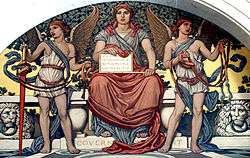Full-reserve banking
| Public finance |
|---|
 |
|
Reform |
Full-reserve banking (also known as 100% reserve banking) is a proposed alternative to fractional reserve banking in which banks would be required to keep the full amount of each depositor's funds in cash, ready for immediate withdrawal on demand. Funds deposited by customers in demand deposit accounts (such as checking accounts) would not be loaned out by the bank because it would be legally required to retain the full deposit to satisfy potential demand for payments. Proposals for such systems generally do not place such restrictions on deposits that are not payable on demand, for example time deposits.[1]
Monetary reforms that included full-reserve banking have been proposed in the past, notably in 1935 by a group of economists, including Irving Fisher, as a response to the Great Depression.[2][3] Currently, no country in the world requires full-reserve banking: banks operating under a full-reserve ratio generally do so by choice or by contract.
Views on full-reserve banking
Economist Milton Friedman at one time advocated a 100% reserve requirement for checking accounts,[4] and economist Laurence Kotlikoff has also called for an end to fractional-reserve banking.[5] Austrian School economist Murray Rothbard has written that reserves of less than 100% constitute fraud on the part of banks and should be illegal, and that full-reserve banking would eliminate the risk of bank runs.[6][7]
Some economists have noted that because banks would not earn revenue from lending against demand deposits, depositors would have to pay fees for the services associated with checking accounts. This, it is felt, would probably be rejected by the public[8][9] although with central bank zero and negative interest rate policies, some writers have noted depositors are already experiencing paying to put their savings even in fractional reserve banks.[10] Economists Diamond and Dybvig have warned that under full-reserve banking, since banks would not be permitted to lend out funds deposited in demand accounts, this function could be expected to be taken over by unregulated institutions. Unregulated institutions (such as high-yield debt issuers) would take over the economically necessary role of financial intermediation and maturity transformation, therefore destabilizing the financial system and leading to more frequent financial crises.[11][12]
In the wake of the 2008 financial crisis, Martin Wolf, chief economist at the Financial times, endorsed full reserve banking, saying "it would bring huge advantages".[3] John H. Cochrane also has come out in favor of full reserve banking.[13] In a response in the New York Times, Paul Krugman stated that the idea was "certainly worth talking about", but worries that it would drive financial activity outside the banking system, into the less regulated shadow banking system.[14]
See also
- Chicago plan
- Fractional-reserve banking
- The Chicago Plan Revisited
- Committee on Monetary and Economic Reform (Canada)
- Money creation
- A Program for Monetary Reform
- Reserve requirement
- Seigniorage
- Austrian business cycle theory
- Positive Money
References
- ↑ A Program for Monetary Reform
- ↑ Fisher, Irving (1935), 100% Money
- 1 2 Weisenthal, Joe. "BAN ALL THE BANKS: Here's The Wild Idea That People Are Starting To Take Seriously". Business Insider.
- ↑ Solow, Robert M. (March 28, 2002), "On the Lender of Last Resort", Financial crises, contagion, and the lender of last resort, Oxford University Press, p. 203, ISBN 978-0-19-924721-9
- ↑ Kotlikoff, Laurence J.; Leamer, Edward (April 23, 2009), "A Banking System We Can Trust" (PDF), Forbes.com, retrieved September 14, 2010
- ↑ Rothbard, Murray N., The Mystery of Banking (PDF), Ludwig von Mises Institute, ISBN 978-1-933550-28-2, retrieved September 14, 2010
- ↑ The Case for a 100% Gold Dollar, Murray Rothbard
- ↑ White, Lawrence H. (Winter 2003). "Accounting for Fractional-Reserve Banknotes and Deposits—or, What's Twenty Quid to the Bloody Midland Bank?" (PDF). The Independent Review. 7 (3): 423–41. ISSN 1086-1653.
- ↑ Allen, William (October 1993). "Irving Fisher and the 100 Percent Reserve Proposal". Journal of Law and Economics. 36 (2): 703–17. doi:10.1086/467295. JSTOR 725805.
- ↑ Texan Gold Depository
- ↑ Diamond, Douglas W.; Philip H. Dybvig (Jan 1986), "Banking Theory, Deposit Insurance, and Bank Regulation", The Journal of Business, 59 (1): 55–68, doi:10.1086/296314, JSTOR 2352687,
In conclusion, 100% reserve banking is a dangerous proposal that would do substantial damage to the economy by reducing the overall amount of liquidity. Furthermore, the proposal is likely to be ineffective in increasing stability since it will be impossible to control the institutions that will enter in the vacuum left when banks can no longer create liquidity. Fortunately, the political realities make it unlikely that this radical and imprudent proposal will be adopted.
- ↑ Diamond, Douglas; Philip Dybvig (Winter 2000). "Bank Runs, Deposit Insurance, and Liquidity" (PDF). Federal Reserve Bank of Minneapolis Quarterly Review. 24 (1): 14–23. Retrieved 29 August 2012.
- ↑ Cochrane, John. "Toward a run - free financial system" (PDF).
- ↑ Krugman, Paul (April 26, 2014). "Is A Banking Ban The Answer?". New York Times. Retrieved September 18, 2015.
External links
- The Chicago Plan Revisited, IMF Working Paper, Jaromir Benes and Michael Kumhof, August 2012
- Alternatives to Conventional Banking Products By Maryam Ayaz
- In Defence of Fractional Reserve Banking (Pascal Salin)